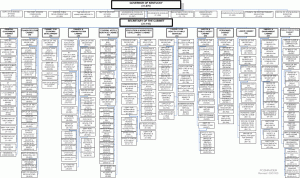Which Boolean Strings will bring up company organizational charts? This question comes up once in a while from recruiters who come to my lectures and on forums.
Here’s a brief beginner guide on how to find where to find org charts. The post also has explanations applicable to finding sites to search for any information of interest.

First and foremost, for 99.99% of the companies out there there are no posted full org charts available for easy viewing online by strangers, for obvious reasons: it is proprietary data. Some companies post partial org charts of their management.
For most companies the org charts cannot be found, even with “strong” search strings, because they are not there. While it may sound trivial, so many people try hard to find what’s not out there -and feel that they don’t know how to search properly!
(1) Let’s imagine that there is a site allowing search for org charts, at least for some org charts. The site(s) might show up in Google search if we use the keywords “org chart” and perhaps also the word “search”, since otherwise we’d mostly find tools to create org charts, which is not of interest at the moment.
The search org chart search brings up a good first result: Cogmap Org Chart Wiki. The site doesn’t try to make money; instead, it offers information exchange. It has 17K charts with almost 300K people. The site was created back in 2006.
The second result, Where to find corporate organization charts, sounds great, but notice that the page was created in 2005, so the info may be a bit outdated (and it is, but is worth exploring).
(Take a look at other results and see what you can find.)
(2) Since we liked Cogmap, a thing to do is also to look for similar sites: related:cogmap.com This brings up another site that is certainly on target and is useful: The organizational charts of the largest corporations
(This search also does bring up “false positives” but we can always ignore them.)
(3) We can also search the posts on the Boolean Strings group, the Internet Sourcing Community. Search for charts and you will find Source people on wikiorgcharts – Check it out! The post points to the site Wikiorgcharts which is, like Cogmap, a crowd-sourcing site and has over a million entries and was created in 2011.
(4) If we look for sites that would have org chart(s) for a particular organization, we might assume that in many cases the words org chart will make it to the title or the URL of those pages. intitle:”org chart” brings up quite a few sites, mostly universities and government sites. (You can exclude some words if you like, such as download, how, software, etc., to remove false positives.)
From the first few minutes of searching we would find lots of those for sites ending in .gov; .edu; .org; and .mil
Here are a few samples of org charts in .gov and .edu sites
- Organization Chart | Department of Energy
- Organizational Chart: About Us: Office of Oceanic and Atmospheric Research
- Federal Aviation Org Charts and Contact Info
- Texas Department of State Health Services
- LSU Organizational Chart
- A collection of org charts for the University of California
Note that some org charts are posted as images, so you can’t Google any names within them; an example is here: NYCHA Organizational Chart (jpg image)
(For those of you who are advanced sourcers: can you figure out what org chart is used for the image above?)





 We would be very happy to accommodate teams of people and address team’s specific sourcing requests. Please
We would be very happy to accommodate teams of people and address team’s specific sourcing requests. Please 





 The grand purpose of this post is to become a substitute for Boolean search cheat sheets, without the need to come back or print it out.
The grand purpose of this post is to become a substitute for Boolean search cheat sheets, without the need to come back or print it out.



